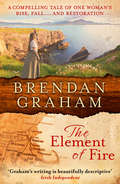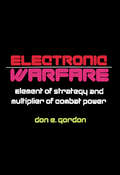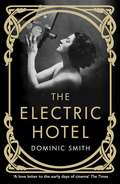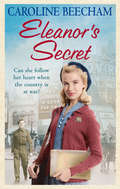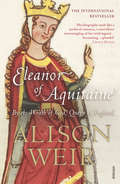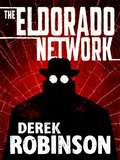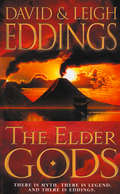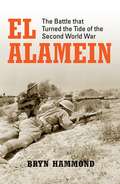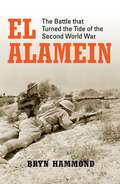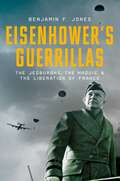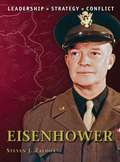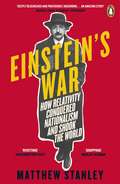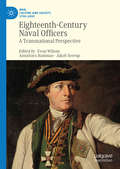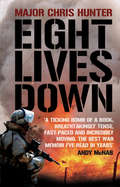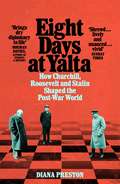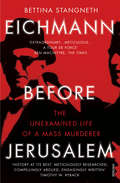- Table View
- List View
The Element of Fire (Magna Large Print Ser.)
by Brendan GrahamRich and epic Historical Fiction set against the backdrop of the Great Famine. Perfect for fans of Winston Graham and Ken Follett.
Elegy: The First Day on the Somme
by Andrew RobertsOn 1 July 1916, after a five-day bombardment, 11 British and 5 French divisions launched their long-awaited 'Big Push' on German positions on high ground above the Rivers Ancre and Somme on the Western Front. Some ground was gained, but at a terrible cost. In killing-grounds whose names are indelibly imprinted on 20th-century memory, German machine-guns – manned by troops who had sat out the storm of shellfire in deep dugouts – inflicted terrible losses on the British infantry. The British Fourth Army lost 57,470 casualties, the French Sixth Army suffered 1,590 casualties and the German 2nd Army 10,000. And this was but the prelude to 141 days of slaughter that would witness the deaths of between 750,000 and 1 million troops. Andrew Roberts evokes the pity and the horror of the blackest day in the history of the British army – a summer's day-turned-hell-on-earth by modern military technology – in the words of casualties, survivors, and the bereaved.
Electronic Warfare: Element of Strategy and Multiplier of Combat Power
by Don E. GordonElectronic Warfare: Element of Strategy and Multiplier of Combat Power describes how the application of electronic warfare allowed the Allies to multiply combat power during World War II in order to accomplish strategic objectives. This book is composed of eight chapters that also consider how the United States had best prepare a strategy to fight on the battlefield with electronic warfare. After briefly presenting the history of electric warfare equipment, this book goes on exploring the technologies of cryptology and microwave radar, and their significance in the battle. These topics are followed by a chapter focusing on the accomplishments of the German surface fleet. The succeeding chapters demonstrate the power of German army with their U-boats, and cruisers, Scheer, Lutzow, Hipper, and Prinz Eugen. The final chapter looks into the issues of preparedness, the cost of defense, the role of technology, political and economic appraisal, and the need to multiply combat power quickly and inexpensively.
Electric Motor (UEB Uncontracted)
In these diagrams of an electric motor, there is an end view on the left of the page and a top view on the right of the page, separated by a vertical dashed line. There is a locator dot shown, which will be at the top left of the page when the image is the right way up. On the end view there is a permanent magnet of south polarity on the left of the page. To the right of this is a large circle which has four electro-magnets around its outer edge. Inside the circle are some thick lines which represent electrical wires that connect the magnets in pairs. Only the wiring connecting one pair of electro-magnets is shown. In the centre is the commutator with the axle in its centre. To the bottom left and upper right of the commutator are the electrical brushes with wires going to the battery (which is not shown). On the far right of the page is a permanent magnet of north polarity. The top view on the right of the page shows the commutator in the bottom right of the page with a single brush. Up from this the electro-magnets are shown. In the end view the permanent magnets to the left and right of the page remain static. The brushes and the wires to the battery also remain static. The electro-magnets, their wiring and the commutator rotate on the axle. The image shows the moment when the positive brush, seen to the upper right of the commutator, supplies electricity to a quadrant of the commutator. This quadrant can then supply electricity via the upper vertical wire to the electro-magnet at the top of the page. The current makes it magnetic with south polarity. This results in the electro-magnet being attracted to and rotating towards the permanent north magnet on the right of the page. The electricity from the charged south electro-magnet flows onwards to the electro-magnet on the opposite side of the diagram, at the bottom of the page, via the longer curved wire. The lower electro-magnet becomes magnetic with north polarity because of the direction of the wiring. This results in the electro-magnet rotating towards the permanent south magnet on the left of the page. The north polarity electro-magnet is currently connected via a vertical wire to a different quadrant of the commutator. As the negative brush contacts this the current can flow back to the battery thus completing the circuit. When this electro-magnet reaches the upper position it will be supplied with electricity again but flowing in the opposite direction so it will become an electro-magnet with south polarity. When the motor is running the pairs of electro-magnets are constantly being turned on and off by the commutator.
Electric Motor (UEB Contracted)
In these diagrams of an electric motor, there is an end view on the left of the page and a top view on the right of the page, separated by a vertical dashed line. There is a locator dot shown, which will be at the top left of the page when the image is the right way up. On the end view there is a permanent magnet of south polarity on the left of the page. To the right of this is a large circle which has four electro-magnets around its outer edge. Inside the circle are some thick lines which represent electrical wires that connect the magnets in pairs. Only the wiring connecting one pair of electro-magnets is shown. In the centre is the commutator with the axle in its centre. To the bottom left and upper right of the commutator are the electrical brushes with wires going to the battery (which is not shown). On the far right of the page is a permanent magnet of north polarity. The top view on the right of the page shows the commutator in the bottom right of the page with a single brush. Up from this the electro-magnets are shown. In the end view the permanent magnets to the left and right of the page remain static. The brushes and the wires to the battery also remain static. The electro-magnets, their wiring and the commutator rotate on the axle. The image shows the moment when the positive brush, seen to the upper right of the commutator, supplies electricity to a quadrant of the commutator. This quadrant can then supply electricity via the upper vertical wire to the electro-magnet at the top of the page. The current makes it magnetic with south polarity. This results in the electro-magnet being attracted to and rotating towards the permanent north magnet on the right of the page. The electricity from the charged south electro-magnet flows onwards to the electro-magnet on the opposite side of the diagram, at the bottom of the page, via the longer curved wire. The lower electro-magnet becomes magnetic with north polarity because of the direction of the wiring. This results in the electro-magnet rotating towards the permanent south magnet on the left of the page. The north polarity electro-magnet is currently connected via a vertical wire to a different quadrant of the commutator. As the negative brush contacts this the current can flow back to the battery thus completing the circuit. When this electro-magnet reaches the upper position it will be supplied with electricity again but flowing in the opposite direction so it will become an electro-magnet with south polarity. When the motor is running the pairs of electro-magnets are constantly being turned on and off by the commutator.
Electric Motor (Large Print)
In these diagrams of an electric motor, there is an end view on the left of the page and a top view on the right of the page, separated by a vertical dashed line. There is a locator dot shown, which will be at the top left of the page when the image is the right way up. On the end view there is a permanent magnet of south polarity on the left of the page. To the right of this is a large circle which has four electro-magnets around its outer edge. Inside the circle are some thick lines which represent electrical wires that connect the magnets in pairs. Only the wiring connecting one pair of electro-magnets is shown. In the centre is the commutator with the axle in its centre. To the bottom left and upper right of the commutator are the electrical brushes with wires going to the battery (which is not shown). On the far right of the page is a permanent magnet of north polarity. The top view on the right of the page shows the commutator in the bottom right of the page with a single brush. Up from this the electro-magnets are shown. In the end view the permanent magnets to the left and right of the page remain static. The brushes and the wires to the battery also remain static. The electro-magnets, their wiring and the commutator rotate on the axle. The image shows the moment when the positive brush, seen to the upper right of the commutator, supplies electricity to a quadrant of the commutator. This quadrant can then supply electricity via the upper vertical wire to the electro-magnet at the top of the page. The current makes it magnetic with south polarity. This results in the electro-magnet being attracted to and rotating towards the permanent north magnet on the right of the page. The electricity from the charged south electro-magnet flows onwards to the electro-magnet on the opposite side of the diagram, at the bottom of the page, via the longer curved wire. The lower electro-magnet becomes magnetic with north polarity because of the direction of the wiring. This results in the electro-magnet rotating towards the permanent south magnet on the left of the page. The north polarity electro-magnet is currently connected via a vertical wire to a different quadrant of the commutator. As the negative brush contacts this the current can flow back to the battery thus completing the circuit. When this electro-magnet reaches the upper position it will be supplied with electricity again but flowing in the opposite direction so it will become an electro-magnet with south polarity. When the motor is running the pairs of electro-magnets are constantly being turned on and off by the commutator.
The Electric Hotel: A Novel
by Dominic SmithFrom the award-winning author of the acclaimed bestseller The Last Painting of Sara de Vos comes a radiant new novel tracing the intertwined fates of a silent film director and his muse.The Electric Hotel winds through the nascent days of cinema in Paris and Fort Lee, New Jersey - America's first movie town - and the battlefields of Belgium during World War I. A sweeping work of historical fiction, it shimmers between past and present as it tells the story of the rise and fall of a prodigious film studio and one man's doomed obsession with all that passes in front of the viewfinder.For nearly half a century, Claude Ballard has been living at the Hollywood Knickerbocker Hotel. A French pioneer of silent films, who started out as a concession agent for the Lumière brothers, the inventors of cinema, Claude now spends his days taking photographs of Sunset Boulevard. But when a film-history student comes to interview Claude about The Electric Hotel - the lost masterpiece that bankrupted him and ended the career of his muse, Sabine Montrose - the past comes surging back. In his run-down hotel suite, the ravages of the past are waiting to be excavated: celluloid fragments and reels in desperate need of restoration, and Claude's memories of the woman who inspired and beguiled him.The Electric Hotel is a portrait of a man entranced by the magic of movie-making, a luminous romance and a whirlwind trip through the heady, endlessly inventive days of early cinema.
Eleanor's Secret
by Caroline BeechamCan Eleanor follow her heart in troubled times?Eleanor Roy is determined to do her bit for the war effort after being recruited by the War Artist Advisory Committee. When she meets handsome artist Jack Valante, her dreams seem to be finally coming true when Jack promises to help her pursue her ambition of becoming an artist. But after a whirlwind romance, Eleanor is devastated when Jack is posted overseas.When Eleanor receives some unexpected news she desperately tries to find Jack. But with the young couple torn apart by war, will they be reunited and find happiness at last?A heartwarming wartime saga perfect for fans of Ellie Dean and Nancy Revell.
Eleanor Of Aquitaine: By the Wrath of God, Queen of England (Ballantine Reader's Circle Ser. #2)
by Alison WeirEleanor, Duchess of Aquitaine was one of the leading personalities of the Middle Ages and also one of the most controversial. She was beautiful, intelligent and wilful, and in her lifetime there were rumours about her that were not without substance. She had been reared in a relaxed and licentious court where the arts of the troubadours flourished, and was even said to have presided over the fabled Courts of Love. Eleanor married in turn Louis VII of France and Henry II of England, and was the mother of Richard the Lionheart and King John. She lived to be 82, but it was only in old age that she triumphed over the adversities and tragedies of her earlier years and became virtual ruler of England. Eleanor has exerted a fascination over writers and biographers for 800 years, but the prevailing myths and legends that attach to her name still tend to obscure the truth. By careful research, Alison Weir has produced a vivid biography with a fresh and provocative perspective on this extraordinary woman.
Eleanor, Countess of Desmond: Captivating Tale of the Forgotten Heroine of the Tudor Wars in Ireland
by Anne ChambersSet in a period of invasion, military conflict, social and political chaos perpetrated by the Tudor conquest of Ireland, the story of Eleanor, Countess of Desmond recounts the heroic efforts of a woman to protect her family against insurmountable odds.Aristocratic, educated, intelligent and able, Lady Eleanor Butler’s destiny was as a wife and mother. But marriage to Garret FitzGerald, the powerful Earl of Desmond, hurls her headlong into a maelstrom of invasion, rebellion, intrigue, appalling cruelty, double-dealing, confiscation plantation, famine, social and political meltdown, as she and her husband become embroiled in a struggle to the death against the formidable, Machiavellian government of Queen Elizabeth I of England.Enduring imprisonment, exile, poverty, hunger and deprivation, her only son held hostage in the Tower of London, her mission to save the House of Desmond, her husband, her children and herself from annihilation becomes Eleanor’s obsession and for which she will sacrifice anything, including herself. When all seems lost, like some latter-day phoenix, she rises, time after time, to bravely confront each new challenge. The life of Eleanor, Countess of Desmond is the story of the triumph of the human spirit against the most horrific adversity.In this vigorous and deeply moving biography that has all the constituents of a Shakespearean tragedy, sourced from primary contemporaneous manuscripts, including the Countess of Desmond’s own letters, Anne Chambers, author of the bestselling Granuaile, vividly brings the life of this neglected heroine to light against the backdrop of one of the most convoluted and traumatic periods in Irish history.
Eldorado Network
by Derek Robinson1941. Hitler rampant. Spain neutral. Madrid, like Casablanca, the launching pad for spies from all sides. The most daring and audacious is codenamed 'Eldorado'. Young, inexperienced, hotheaded, he had no right to survive, let alone succeed. Now his network is the most valuable in Europe, and the fates of armies lie in his hands.But who does he work for? Or is he only in it for himself? One thing's for sure. War may be a dirty business, but it certainly brings home the bacon. Based on a true story, The Eldorado Network is the first novel in Derek Robinson's acclaimed Luis Cabrillo Quartet. A tense and gripping espionage thriller from a master of action and suspense.
The Elder Gods: Book One Of The Dreamers (The\dreamers Ser. #Bk. 1)
by David Eddings Leigh EddingsA new world and a glorious story destined to reach the biggest audience yet.
El Alamein: The Battle that Turned the Tide of the Second World War
by Bryn HammondBefore the Battle of El Alamein in 1942, the British had never won a major battle on land against the Germans; nor indeed had anyone else. Drawing on a remarkable array of first-hand accounts, this book reveals the personal experiences of those on the frontline and provides fascinating details of how the war was actually fought. It also includes analysis of the strategic decisions made by the generals. El Alamein 1942 is the story of exactly how a seemingly beaten and demoralized army turned near-defeat into victory in a little over four months of protracted and bloody fighting in the harsh North African desert.
El Alamein: The Battle that Turned the Tide of the Second World War (General Military Ser.)
by Bryn HammondBefore the Battle of El Alamein in 1942, the British had never won a major battle on land against the Germans; nor indeed had anyone else. Drawing on a remarkable array of first-hand accounts, this book reveals the personal experiences of those on the frontline and provides fascinating details of how the war was actually fought. It also includes analysis of the strategic decisions made by the generals. El Alamein 1942 is the story of exactly how a seemingly beaten and demoralized army turned near-defeat into victory in a little over four months of protracted and bloody fighting in the harsh North African desert.
Eisenhower's Guerrillas: The Jedburghs, the Maquis, and the Liberation of France
by Benjamin F. JonesThe challenges facing General Dwight Eisenhower before the Invasion of Normandy were not merely military but political as well. He knew that to liberate France, and to hold it, the Allies needed local help, which would necessitate coordinating with the highly independent French resistance groups known collectively as the maquis. The Allies' objective was to push the Germans out of France. The French objective, on the other hand, was a France free of all foreign armies, including the Allies. President Roosevelt refused to give full support to Charles de Gaulle, whom he mistrusted, and declined to supply the timing, location, and other key details of Operation Overlord to his Free French government. Eisenhower's hands were tied. He needed to involve the French, but without simultaneously involving them in operational planning. Into this atmosphere of tension and confusion jumped teams consisting of three officers each -- one from the British Special Operations Bureau, one from the U.S. Office of Strategic Services, one from the Free French Bureau Central de Renseignement -- as well as a radioman from any one of the three nations. Known as the Jedburghs, their primary purpose was to serve as liaisons to the maquis, working to arm, train, and equip them. They were to incite guerilla warfare. Benjamin Jones' Eisenhower's Guerrillas is the first book to show in detail how the Jedburghs -- whose heroism and exploits have been widely celebrated -- and the maquis worked together. Underscoring the critical and often overlooked role that irregular warfare played in Allied operations on the Continent, it tells the story of the battle for and liberation of France and the complexities that threatened to undermine the operation before it even began.
Eisenhower's Guerrillas: The Jedburghs, the Maquis, and the Liberation of France
by Benjamin F. JonesThe challenges facing General Dwight Eisenhower before the Invasion of Normandy were not merely military but political as well. He knew that to liberate France, and to hold it, the Allies needed local help, which would necessitate coordinating with the highly independent French resistance groups known collectively as the maquis. The Allies' objective was to push the Germans out of France. The French objective, on the other hand, was a France free of all foreign armies, including the Allies. President Roosevelt refused to give full support to Charles de Gaulle, whom he mistrusted, and declined to supply the timing, location, and other key details of Operation Overlord to his Free French government. Eisenhower's hands were tied. He needed to involve the French, but without simultaneously involving them in operational planning. Into this atmosphere of tension and confusion jumped teams consisting of three officers each -- one from the British Special Operations Bureau, one from the U.S. Office of Strategic Services, one from the Free French Bureau Central de Renseignement -- as well as a radioman from any one of the three nations. Known as the Jedburghs, their primary purpose was to serve as liaisons to the maquis, working to arm, train, and equip them. They were to incite guerilla warfare. Benjamin Jones' Eisenhower's Guerrillas is the first book to show in detail how the Jedburghs -- whose heroism and exploits have been widely celebrated -- and the maquis worked together. Underscoring the critical and often overlooked role that irregular warfare played in Allied operations on the Continent, it tells the story of the battle for and liberation of France and the complexities that threatened to undermine the operation before it even began.
Eisenhower (Command)
by Steven J. Zaloga Steve NoonDwight Eisenhower represented a fundamentally new type of modern military commander. Eisenhower was a manager commander, whose grasp of the politics and large-scale tactics of battle were uniquely suited to leading the huge coalition of forces that fought in Europe during the Second World War. Educated at West Point, Eisenhower rose to his position as Supreme Commander of the Allied Expeditionary Force through a series of powerful contacts and his natural aptitude for leadership and large scale tactical planning. This book analyses how Eisenhower's tactics and political astuteness helped him successfully lead the invasion of Europe, how he coaxed contradictory parties into supporting his policies and how he triumphed in his now infamous clash with Montgomery. Uniquely, the author goes on to describe how Eisenhower's military influence continued when he became President, as his leadership and vision were tested by the outbreak of the Cold War.
Einstein's War: How Relativity Conquered Nationalism and Shook the World
by Matthew StanleyHow an unknown German and an Englishman on opposite sides of WWI created a scientific revolutionIn 1916, Arthur Eddington, a war-weary British astronomer, opened a letter written by an obscure German professor named Einstein. The neatly printed equations on the scrap of paper outlined his world-changing theory of general relativity. Until then, Einstein's masterpiece of time and space had been trapped behind the physical and ideological lines of battle, unknown. Many Britons were rejecting anything German, but Eddington realized the importance of the letter: perhaps Einstein's esoteric theory could not only change the foundations of science but also lead to international co-operation in a time of brutal war.Few recognize how the Great War, the industrialized slaughter that bled Europe from 1914 to 1918, shaped Einstein's life and work. While Einstein never held a rifle, he formulated general relativity blockaded in Berlin, literally starving. His name is now synonymous with 'genius', but it was not an easy road. This was, after all, the first complete revision of our conception of the universe since Isaac Newton.Its victory was far from sure. Einstein spent a decade creating relativity and his ascent to global celebrity, which saw him on front pages around the world, also owed much to against-the-odds international collaboration, including Eddington's crucial, globe-spanning expedition of 1919 - which was still two years before they finally met - to catch a fleeting solar eclipse for a rare opportunity to confirm Einstein's bold prediction that light has weight.We usually think of scientific discovery as a flash of individual inspiration, but here we see it is the result of hard work, gambles and wrong turns. Einstein's War is a celebration of how bigotry and nationalism can be defeated and of what science can offer when they are. Using previously unknown sources and written like a thriller, it sheds light on science through history: we see relativity built brick-by-brick in front of us, as it happened 100 years ago.
Ein Volk, Ein Reich: Nine Lives Under the Nazis (History Press Ser.)
by Louis HagenWhen Louis Hagen returned to Berlin immediately after the war, having survived not only incarceration and torture in a German concentration camp but also the Battle of Arnhem, it was through a desire to see the great German eagle toppled, its talons drawn. the son of a wealthy Jewish banker, he had seen his family flee their home, and many of his relatives had died at the hands of the Third Reich. He wanted to understand the German people; why had so many welcomed the Nazi Party, and were they now humbled and wiser? Hagen interviewed nine people he had known before the war who represented a wide spectrum of German society. They were an SA officer, a businessman, a doctor, a socialite, a journalist, a professional soldier, an SS wife, a member of the Hitler Youth and a mischling, or half Jew. Four were Nazis, three were collaborators, and two were anti-Nazi. The very fact that none of these people was a high-ranking Nazi official or a survivor of the Holocaust provides an insight into the Third Reich that is a revelation even for those who know this period of history intimately. howe could the Baroness sent To Theriesenstadt concentration camp hold salons for ex-Nazis after the war? Through the lives of nine ordinary Germans, tracing their experiences of Nazism from the first hopeful days until the horrors of the Russian occupation of Berlin, Louis Hagen provides a salutary and unforgettable record of the German people in the shadow of the swastika.
Eighteenth-Century Naval Officers: A Transnational Perspective (War, Culture and Society, 1750 –1850)
by Evan Wilson AnnaSara Hammar Jakob SeerupThis book surveys the lives and careers of naval officers across Europe at the height of the age of sail. It traces the professionalization of naval officers by exploring their preparation for life at sea and the challenges they faced while in command. It also demonstrates the uniqueness of the maritime experience, as long voyages and isolation at sea cemented their bond with naval officers across Europe while separating them from landlubbers. It depicts, in a way no previous study has, the parameters of their shared experiences—both the similarities that crossed national boundaries and connected officers, and the differences that can only be seen from an international perspective.
Eight Lives Down: Audible Format
by Chris HunterSEARING HEATYou have the most dangerous job in the world's most dangerous place. You are responsible for bomb disposal in the British sector of Iraq.You are the last defence against oblivion. And it's already a hundred degrees in the shade. , COLD FEARYou are up against some of the most sophisticated bombmakers in the world. They don't play by the rules of the Geneva Convention. Nothing but your own wits will save you. You're on your own. SILENCENow is the moment of truth. All you can hear is the sound of your own blood pounding through your veins. This could be your last moment on earth.IT'S JUST YOU AND THE BOMB
Eight Days in May: How Germany's War Ended
by Volker Ullrich'The last days of the Third Reich have often been told, but seldom with the verve, perception and elegance of Volker Ulrich's rich narrative ... an instructive lesson in how societies cope with the devastating reality of a surrender that they grimly await' Richard Overy, author of The Bombing War'A fast-paced, brilliant recounting of the turbulent last days of the Third Reich, with all the energy and chaos of a Jackson Pollock canvas' Helmut Walser Smith, author of Germany: A Nation in its Time1 May 1945. The world did not know it yet, but the final week of the Third Reich's existence had begun. Hitler was dead, but the war had still not ended. Everything had both ground to a halt and yet remained agonizingly uncertain.Volker Ullrich's remarkable book takes the reader into a world torn between hope and terror, violence and peace. Ullrich describes how each day unfolds, with Germany now under a new Führer, Admiral Dönitz, based improbably in the small Baltic town of Flensburg. With Hitler dead, Berlin in ruins and the war undoubtedly lost, the process by which the fighting would end remained horrifyingly unclear. Many major Nazis were still on the loose, wild rumours continued to circulate about a last stand in the Alps and the Western allies falling out with the Soviet Union.All over Europe, millions of soldiers, prisoners, slave labourers and countless exhausted, grief-stricken and often homeless families watched and waited for the war's end. Eight Days in May is the story of people, in Erich Kästner's striking phrase, stuck in 'the gap between no longer and not yet'.
Eight Days at Yalta: How Churchill, Roosevelt and Stalin Shaped the Post-War World
by Diana PrestonMeticulously researched and vividly written, Eight Days at Yalta is a remarkable work of intense historical drama.In the last winter of the Second World War, Winston Churchill, Franklin D. Roosevelt and Joseph Stalin arrived in the Crimean resort of Yalta. Over eight days of bargaining, bombast and intermittent bonhomie they decided on the conduct of the final stages of the war against Germany, on how a defeated and occupied Germany should be governed, on the constitution of the nascent United Nations and on spheres of influence in Eastern Europe, the Balkans and Greece.Only three months later, less than a week after the German surrender, Roosevelt was dead and Churchill was writing to the new President, Harry S. Truman, of ‘an iron curtain’ that was now ‘drawn down upon [the Soviets’] front’. Diana Preston chronicles eight days that created the post-war world, revealing Roosevelt’s determination to bring about the dissolution of the British Empire and Churchill’s conviction that he and the dying President would run rings round the Soviet premier. But Stalin monitored everything they said and made only paper concessions, while his territorial ambitions would soon result in the imposition of Communism throughout Eastern Europe.
Eichmann in Jerusalem: Ein Bericht Von Der Banalität Des Bösen (Palabra En El Tiempo Ser. #Vol. 271)
by Hannah ArendtHannah Arendt's authoritative and controversial report on the trial of German Nazi leader Adolf Eichmann first appeared as a series of articles in the New Yorker in 1963. This revised edition of Eichmann in Jerusalem contains further factual material that came to light after the trial, as well as Arendt's postscript commenting on the controversy that arose over her book.
Eichmann before Jerusalem: The Unexamined Life of a Mass Murderer
by Bettina StangnethA New York Times Notable Book of 2014Smuggled out of Europe after the collapse of Germany, Eichmann managed to live a peaceful and active exile in Argentina for years before his capture by the Mossad. Though once widely known by nicknames such as 'Manager of the Holocaust', he was able to portray himself, from the defendant's box in Jerusalem in 1960, as an overworked bureaucrat following orders – no more, he said, than 'just a small cog in Adolf Hitler's extermination machine'.How was this carefully crafted obfuscation possible? How did a principal architect of the Final Solution manage to disappear? How had he occupied himself in hiding?Drawing upon an astounding trove of newly discovered documentation, Stangneth gives us a chilling portrait not of a reclusive, taciturn war criminal on the run, but of a highly skilled social manipulator with an inexhaustible ability to reinvent himself, an unrepentant murderer eager for acolytes to discuss past glories and vigorously planning future goals.
